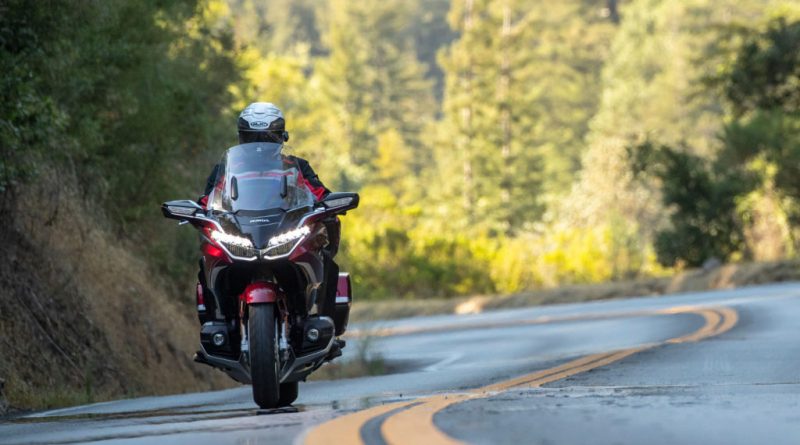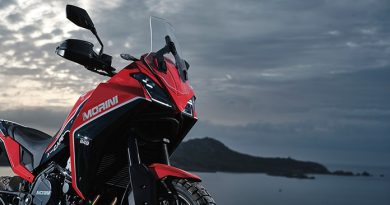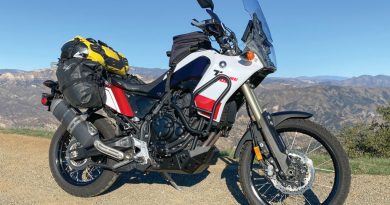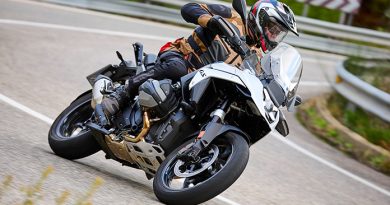2021 Honda Gold Wing Tour DCT | Road Test Review
With its front fairing
and headlights shaped like the spread wings of the Gold Wing logo, it’s easy to identify Honda’s flagship
touring bike coming
your way. (Photos by Kevin Wing)
Honda’s first complete motorcycle, the D-Type, was built in 1949, just four years after the end of World War II. The D-Type was also known as the Dream, and although the exact origins of that name are unknown, the new motorcycle was a significant step toward realizing Soichiro Honda’s vision for the company that bore his name.
A former race-car driver and brilliant engineer, Mr. Honda was the charismatic, outspoken leader of Honda Motor Company, Ltd. for decades. From humble beginnings, Honda became the world’s largest engine and motorcycle manufacturer, as well as one of the world’s largest automobile manufacturers. The company also makes ATVs, power equipment, aircraft, and robots, and it has competed in and won championships in nearly every form of motorcycle and car racing.
Honda has created many groundbreaking motorcycles in the 72 years since the D-Type first emerged, from the Super Cub C100 – with more than 100 million units built since 1958, it’s the most produced motor vehicle in history – to the CB750 to the Gold Wing.
The 2021 Honda Gold Wing Tour is available in Candy Ardent Red (above) and Metallic Black.
A Wing Fit for a King…
As one of Honda’s most long-lived models, the Gold Wing has been critical to the company’s success, particularly in the U.S. Inspired by Honda’s “King of Kings” M1 prototype, the first Gold Wing – the 1975 GL1000 – was the second most powerful production motorcycle at the time, edged out by the Kawasaki Z-1. The GL1000’s flat-Four engine layout and liquid cooling set a precedent for smooth, quiet performance.
The Gold Wing created a new market, meeting pent-up demand for dependable, luxurious long-distance motorcycle touring. Its comfort and reliability made it easy for more people to ride more miles, and Honda’s new touring customers became an integral part of the design and development process. Owners were willing to trade top-end power for better midrange performance, so as the GL evolved, peak torque rpm moved closer to cruising rpm.
When Honda introduced the GL1100 in 1980, it offered an Interstate version with a fairing, windscreen, saddlebags, a trunk, and a plush king-and-queen seat. Two years later, Honda brought out an even more luxurious version called the Aspencade. You could still buy a naked version of the Gold Wing when the GL1200 was introduced for 1984, but by 1985 the only models available were the Interstate, Aspencade, and Limited Edition. The market had spoken, and from then until now Gold Wings have been outfitted for touring.
As long-time readers know, Rider’s history parallels that of the Gold Wing. Denis Rouse founded Rider in 1974, the same year the GL1000 was introduced (for the 1975 model year). The success of the magazine and the Gold Wing grew in parallel as the touring market grew rapidly in the late ’70s and ’80s. Over the years, we’ve published dozens of tests and features that showcase the Gold Wing. Including this issue, it has been on our cover numerous times, and it won Rider’s Motorcycle of the Year award in 2001 and 2018.
This winged Honda badge is reserved for its flagship models, like the Gold Wing and the CBR1000RR-R Fireblade SP.
… And a Queen
Many Gold Wing owners can and do ride solo – in fact, most of the miles I logged for this test were done without a passenger – but the Wing’s true calling is well-appointed two-up travel. In his first ride review, Ken Lee and his wife Katie evaluated the 2021 updates to the Gold Wing Tour, which include better passenger accommodations, a bigger trunk (now 61 liters, with 121 liters of total storage capacity; the standard, non-Tour Gold Wing foregoes the trunk), and improvements to the styling and audio system. Compared to the previous-generation 2008 GL1800 in their garage, Ken and Katie both found the accommodations and ergonomics more to their liking.
Former EIC Mark Tuttle and his wife Genie did many two-up tests of Gold Wings over the years. As a wet-behind-the-ears staffer with less than a year on the job, I was tasked with testing a 2009 GL1800 for Rider’s 35th-anniversary issue (April 2009). At the time I had just started dating my wife Carrie, and she had never been on a motorcycle before. What better way to welcome her to the joys of two-wheeling than the plush back seat of a Gold Wing? She was immediately hooked. Spoiled right out of the gate, she has measured every other motorcycle she has ridden with me against the gold standard of the Gold Wing.
Most of the time our Gold Wing’s 7-speed automatic Dual Clutch Transmission enhanced the touring experience by eliminating the need for clutching and shifting. But on winding back roads, I preferred putting the DCT in manual mode and using the paddle shifters.
For that 2009 road test, photographer Rich Cox – with him riding the magazine’s former photo wagon, a black 2000 25th-anniversary GL1500SE – and I rode up California’s western edge from Ventura to Monterey on Highway 1, which hugs the rugged, dramatic coast for 100 miles from Cambria to Carmel. For this test, photographer Kevin Wing – who was a protégé of Rich’s in the early part of his career – and I followed the same northern route.
Torque and a Fork
With a perfectly balanced, liquid-cooled flat-Six displacing 1,833cc, the Gold Wing’s engine churns out a big dollop of creamy smooth torque whenever you twist the grip. When we dyno’d a 2018 GL1800, the peak rear-wheel torque was 106 lb-ft at 4,500 rpm, and more than 100 lb-ft was available between 2,000 and 5,000 rpm. With no mechanical changes since then, the results should be about the same for our 2021 GL1800.
With the Gold Wing in Tour mode, throttle response is relaxed, and its optional 7-speed Dual Clutch Transmission (DCT) quickly shifts into higher gears to keep rpm low and fuel efficiency high. (Over the course of 1,300 testing miles, we’ve averaged 40 mpg and 224 miles of range. Admittedly, we’ve ridden the Wing hard and fast, so typical numbers will be higher.) It’s common to be trundling along at a modest pace on a twisty road with the DCT in 6th gear, yet on corner exits the Gold Wing’s torque-rich Six will pull all 838 pounds of bike plus hundreds more pounds of rider, passenger, and gear along without breaking a sweat.
Strangely, for a motorcycle clearly designed for touring, I found Sport mode to be way too abrupt. Rain and Econ modes serve a purpose, but I largely ignored them. When I didn’t want the DCT to upshift too early or fight to find the right gear when transitioning back and forth between corners on curvy roads like Highway 1, I put it into manual mode and used the paddle buttons to quickly shift up or down. With such a broad spread of torque, often I’d leave it in 3rd gear and control revs and speed with the throttle.
Big rotors are squeezed by gorilla-grip 6-piston calipers.
The ride mode also affects suspension damping, and when stopped the rider can dig into the menu to set rear preload. When riding solo on the photo-shoot ride with Kevin, I set rear preload to two-up plus luggage, which increased cornering clearance such that I rarely scraped pegs, even when riding at a brisk pace.
What most sets the current-gen GL1800 apart from its predecessors is its double-wishbone front suspension, which separates steering dynamics from suspension action and prevents fork dive under braking, a useful feature on such a heavy bike with strong, responsive brakes. The suspension offers good compliance and isolates the rider and passenger from vibration, but it also isolates the rider from front-end feedback. From the cockpit you can watch the tie-rod ends bounce rapidly up and down over bumps, seams, and ripples, yet the connection with the road often feels vague and distant. A rider can push the current Gold Wing as hard as they want and it will respond dutifully, but it lacks some of the light, intuitive steering response of the previous-generation GL1800.
Riding across
Bixby Bridge, an
iconic location on
California’s Highway 1
north of Big Sur. Built
in 1932, at 280 feet, it
was once the highest
single-span arch
bridge in the world.
The Stuff of Dreams
As Ken Lee wrote about in his review, the Gold Wing has been unfairly maligned over the years as an “old man’s bike.” Sure, there are thousands of Gold Wings out there ridden by older couples, sometimes with their bikes adorned with flags, cup holders, and stuffed animals lashed to trunk racks. With the sixth-generation Gold Wing, Honda made the bike lighter and gave it sportier styling and state-of-the-art tech, perhaps to attract younger buyers but also to keep evolving its flagship touring bike.
When the GL1800 replaced the GL1500 for 2001, Wing Nuts decried the loss of storage capacity, particularly the replacement of the cavernous, boxy trunk with a smaller one that looks sleek from the outside but has an oddly shaped interior. For 2021, Honda added storage capacity to the trunk, and it’s easy to load but frustratingly hard to close when full of gear. Nearly every time I closed the trunk, a warning message would appear on the dash that, nope, still not closed all the way. I got into the habit of slamming the trunk shut, which made me cringe.
Mission control includes a large, full-color center display
for navigation, audio, and other infotainment functions.
Analog gauges are flanked by smaller LCD displays.
Details matter, and Honda has always sweated the details on the Gold Wing. When you put miles on the new Gold Wing over the course of multiple days, you can’t help but be impressed. Sure, there’s a learning curve with its buttons and menus, but once you get things dialed in, you can mostly set it and forget it. While Kevin trailed me on our KTM 890 Adventure R long-term test bike, I cruised along in the lap of luxury. Temperatures ranged from the low 50s on the coast to 102 degrees inland, and I adjusted the electric windscreen or turned on the heated grips or set the cruise control or changed riding modes as desired. If anything, at times I felt a little too comfortable, especially in the heat of the day after lunch. That’s when I cranked up the heavy metal tunes to ward off the drowsies.
Why, yes, the Gold
Wing will cruise
at 75 mph on a
dirt road. With
its electronic
suspension set for
comfort in Tour
mode, it floats
right along.
Thirteen years after our first ride together, with Carrie donning the same riding jacket that we had mothballed in the garage, we took a leisurely cruise on many of the same roads on the new Gold Wing that we had explored on the 2009 model. As Carrie sat comfortably in the passenger seat, hugged securely by the wrap-around backrest and perched high enough to enjoy the view (I’m much taller than she is), we enjoyed a trip down memory lane. During our lunch stop, we reminisced about our early days of dating, the many rides we’ve been on over the years, getting engaged atop Stelvio Pass in Italy, and spending our honeymoon on a Norway tour with Edelweiss Bike Travel.
Motorcycles really are dream machines. We fantasize about the bikes we want, and we use them to fulfill dreams with bucket-list adventures. They bring us together and help us create lasting memories. When Carrie and I returned home from our nostalgic ride, she said, “If we can only own one motorcycle, this has to be it.” As you wish.
2021 Honda Gold Wing Tour Specs
Base Price: $28,300
Price as Tested: $29,300 (DCT model)
Warranty: 3 yrs., unltd. miles, transferable
Website: powersports.honda.com
ENGINE
Type: Liquid-cooled, longitudinal opposed flat-Six, Unicam SOHC w/ 4 valves per cyl.
Displacement: 1,833cc
Bore x Stroke: 73.0 x 73.0mm
Compression Ratio: 10.5:1
Valve Insp. Interval: 24,000 miles
Fuel Delivery: EFI w/ 50mm throttle body
Lubrication System: Wet sump, 3.9 qt. cap
Transmission: 7-speed Dual Clutch Transmission automatic (as tested)
Final Drive: Shaft, 1.795:1
CHASSIS
Frame: Aluminum tubular & box-section double cradle w/ single-sided cast aluminum swingarm
Wheelbase: 66.7 in.
Rake/Trail: 30.5 degrees/4.3 in.
Seat Height: 29.3 in.
Suspension, Front: Double-wishbone w/ single shock, electronically adj. (as tested), 4.3 in. travel
Rear: Pro-Link w/ single shock, electronically adj. (as tested), 4.1 in. travel
Brakes, Front: Dual 320mm discs w/ 6-piston opposed calipers & C-ABS
Rear: Single 316mm disc w/ 3-piston floating caliper & C-ABS
Wheels, Front: Cast, 3.50 x 18 in.
Rear: Cast, 5.00 x 16 in.
Tires, Front: 130/70-R18
Rear: 200/55-R16
Wet Weight: 838 lbs.
Load Capacity: 421 lbs.
GVWR: 1,259 lbs.
PERFORMANCE
Horsepower: 101 @ 5,500 rpm (2018 model, rear-wheel dyno)
Torque: 106 @ 4,500 rpm (2018 model, rear-wheel dyno)
Fuel Capacity: 5.6 gals.
Fuel Consumption: 40 mpg
Estimated Range: 224 miles
The post 2021 Honda Gold Wing Tour DCT | Road Test Review first appeared on Rider Magazine.




